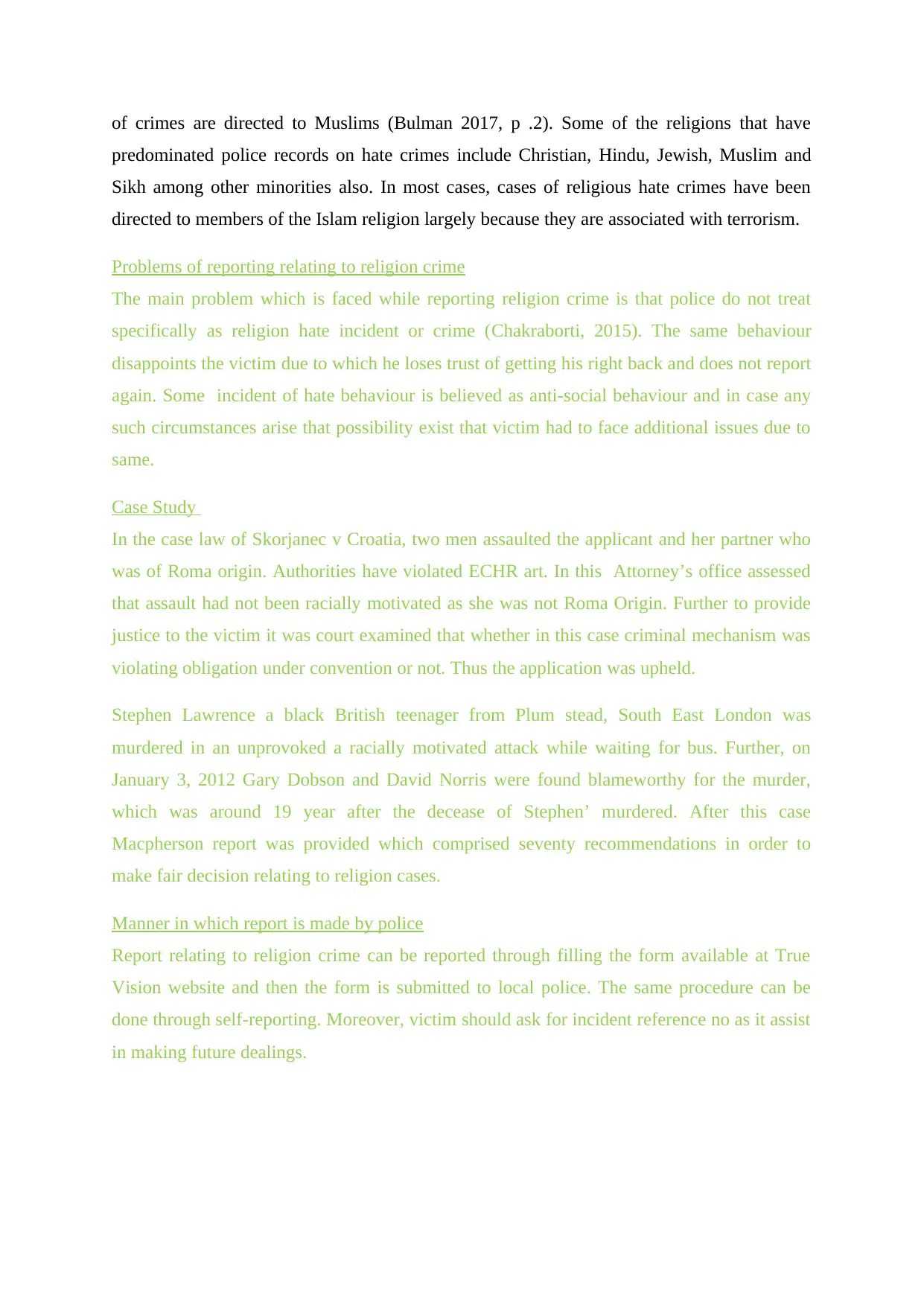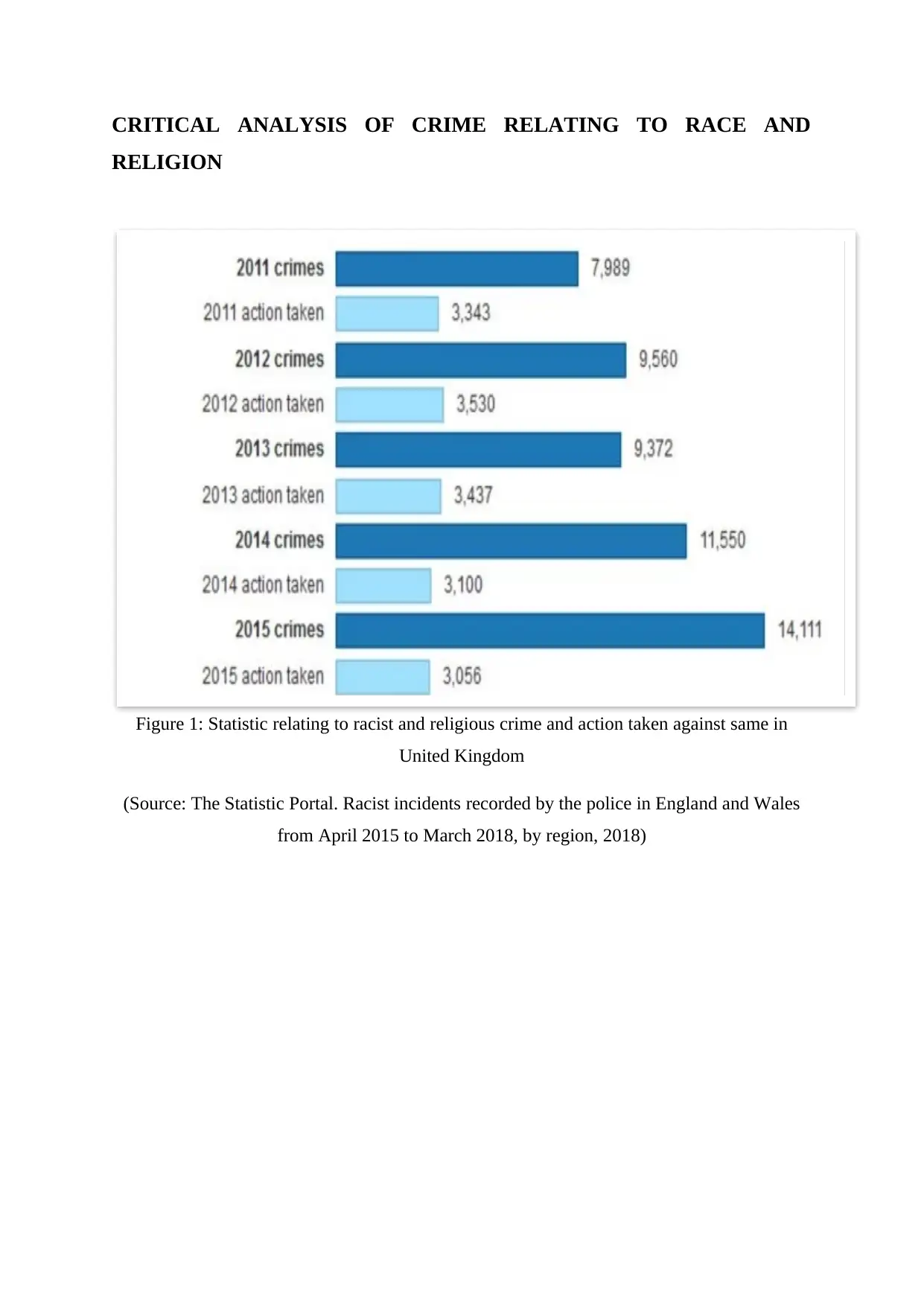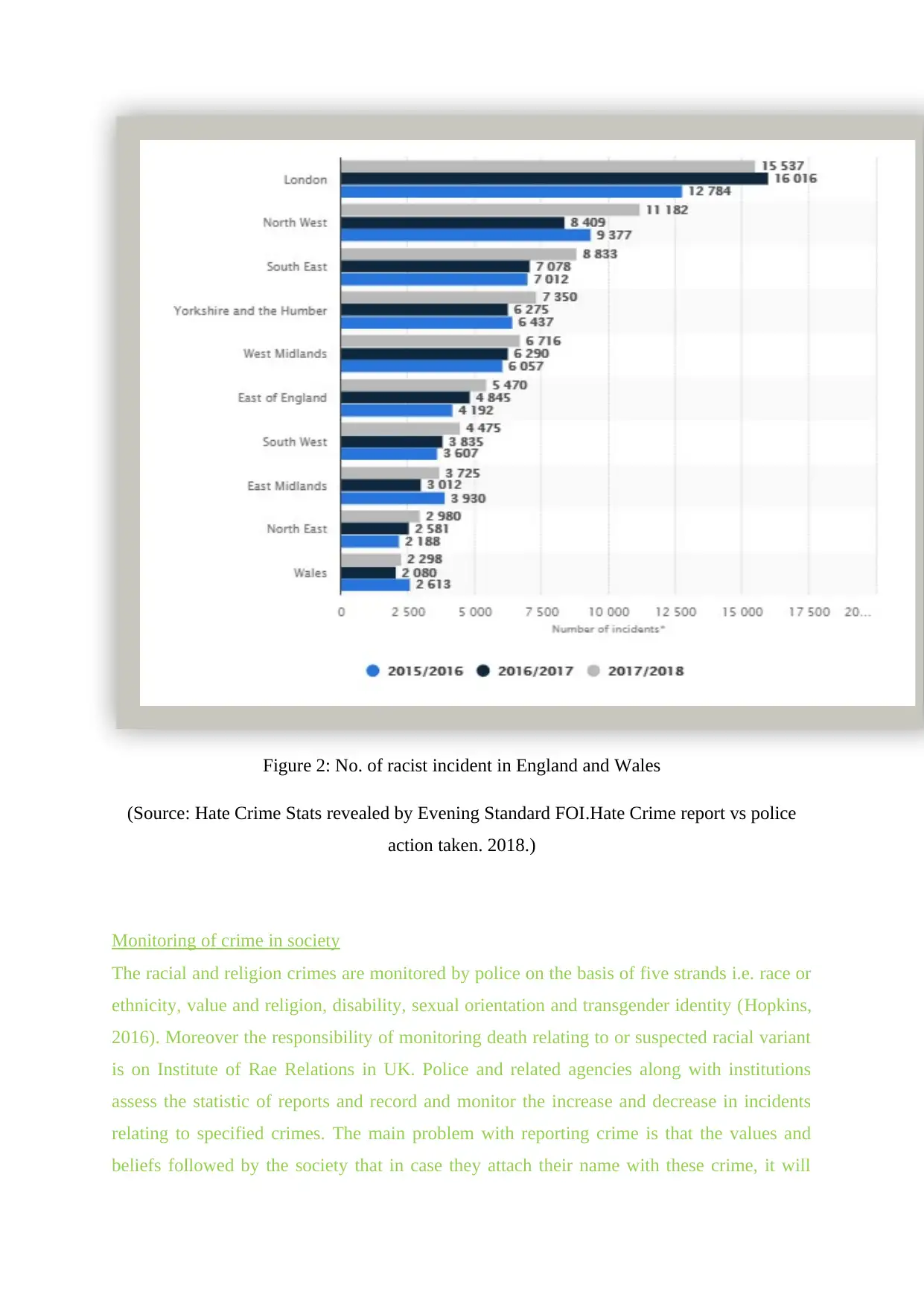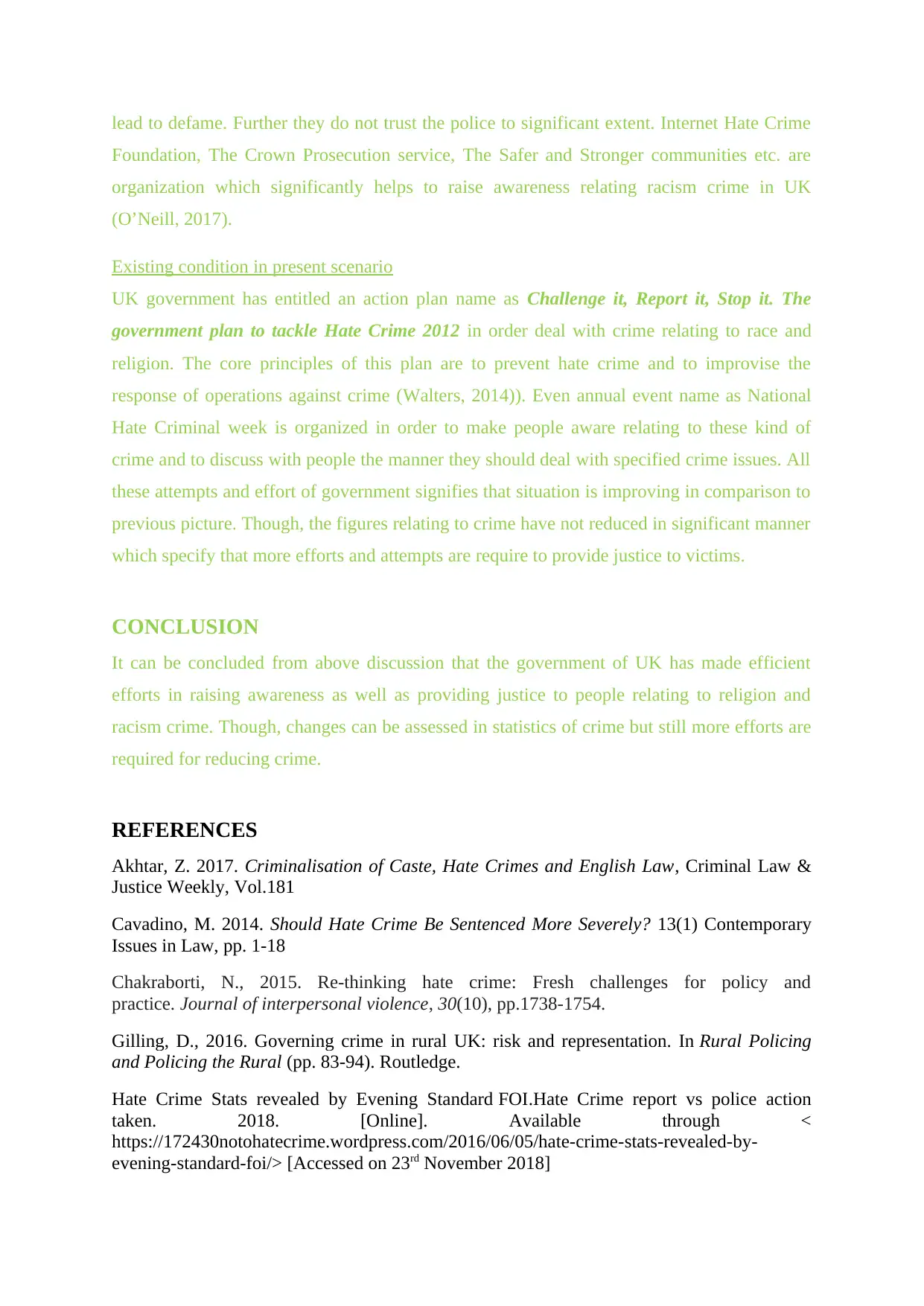Examining Hate Crime in England and Wales under the Equality Act 2010
VerifiedAdded on 2023/05/29
|7
|2020
|298
AI Summary
This paper examines the issues related to reporting and monitoring of hate crime in England and Wales, with a focus on race and religion under the Equality Act 2010. It discusses the core analysis of racist and religious hate crimes, provisions relating to protection by law, problems of reporting, and the manner in which reports are made by police.
Contribute Materials
Your contribution can guide someone’s learning journey. Share your
documents today.

INTRODUCTION
Equality Act was developed by English government in year 2010 to codify the critical
extensive range of provision and regulations which are applied as base of anti-discrimination
law in UK (Akhtar, 2017). The Equality Act highlighted the key groups of people to be
protected from acts of discrimination, which are referred to as the ‘protected characteristics.’
Primarily, the Act protected these groups from any acts or omissions that would eventually
lead to them being discriminated or facing hate crimes. A hate crime can broadly be defined
as a type of crime that occurs to someone (a victim) based on prejudices by the perpetrator
such as on their racial extraction or even membership in certain social organizations/groups,
for example, groups such as those related to sex, religious orientation or even gender identity.
Present discussion revolves around two major issues of Equality Act 2010 i.e. Race and
Religion. Further, the manner in which these crimes are protected by law as well as the
existing condition has been discussed in order to assess the manner in which same can be
improved. This paper applies some of the protected characteristics under the Equality Act
2010 to extensively examine and explore some of the critical issues related to the reporting
and monitoring of hate crime in England and Wales.
PROTECTED CHARACTERISTIC 1-RACE
Core analysis of racist crime
In accordance with assertions of Cavadino(2014), racist hate crimes are acts that are
committed and are made to indicate or show some level of prejudice to the victims based on
their race. Thereby such acts are seen and perceived as hostile ways of dealing with members
of a different race which the perpetrators don’t seem to support or agree with. Therefore,
racist hate crimes are perceived to be committed due to biases towards either of the above
social groups or any other groups allied or related to them.
A racial group can largely be said to be a group of people that can be defined primarily on
the grounds of their distinct as well as shared physical or social attributes and characteristics.
These shared attributes may include skin colour, language of communication and country of
origin as well as racial extraction among other easily identifiable and distinguishable
attributes (Hanes and Machin 2014, p.115) people who experience hostility and any form of
harassment either directly or indirectly have the right to report the matter to any law
Equality Act was developed by English government in year 2010 to codify the critical
extensive range of provision and regulations which are applied as base of anti-discrimination
law in UK (Akhtar, 2017). The Equality Act highlighted the key groups of people to be
protected from acts of discrimination, which are referred to as the ‘protected characteristics.’
Primarily, the Act protected these groups from any acts or omissions that would eventually
lead to them being discriminated or facing hate crimes. A hate crime can broadly be defined
as a type of crime that occurs to someone (a victim) based on prejudices by the perpetrator
such as on their racial extraction or even membership in certain social organizations/groups,
for example, groups such as those related to sex, religious orientation or even gender identity.
Present discussion revolves around two major issues of Equality Act 2010 i.e. Race and
Religion. Further, the manner in which these crimes are protected by law as well as the
existing condition has been discussed in order to assess the manner in which same can be
improved. This paper applies some of the protected characteristics under the Equality Act
2010 to extensively examine and explore some of the critical issues related to the reporting
and monitoring of hate crime in England and Wales.
PROTECTED CHARACTERISTIC 1-RACE
Core analysis of racist crime
In accordance with assertions of Cavadino(2014), racist hate crimes are acts that are
committed and are made to indicate or show some level of prejudice to the victims based on
their race. Thereby such acts are seen and perceived as hostile ways of dealing with members
of a different race which the perpetrators don’t seem to support or agree with. Therefore,
racist hate crimes are perceived to be committed due to biases towards either of the above
social groups or any other groups allied or related to them.
A racial group can largely be said to be a group of people that can be defined primarily on
the grounds of their distinct as well as shared physical or social attributes and characteristics.
These shared attributes may include skin colour, language of communication and country of
origin as well as racial extraction among other easily identifiable and distinguishable
attributes (Hanes and Machin 2014, p.115) people who experience hostility and any form of
harassment either directly or indirectly have the right to report the matter to any law
Secure Best Marks with AI Grader
Need help grading? Try our AI Grader for instant feedback on your assignments.

enforcement agency such as the police or even a local administration who will record such
acts as hate crimes under the Equality Act, 2010 and to take the necessary remedial measures
as provided for in the law against the perpetrator of such acts.
Provisions relating to protection by law
Gilling (2016) stated that any individual or victim who has faced such issue can report to the
police in their area. Police is responsible to record all incidents relating to hate crime even the
same does not comprise all the variants in order to be classified as crime. The same enhances
the reach of hate crime umbrella. Moreover in case any incident is believed not to be crime at
prima facia the same is required to be recorded in case it meets the threshold limit specified
bin Macpherson definition of racist incident. Thus, it can be accessed from above discussion
that even if minor probability of racist hate crime exist than an individual is having right to
complain against same.
Case Study
Committing a racist hate crime may amount to a criminal act and normally involves acts such
as property damage, uttering verbal insults, bullying or even sending out of letters which
contain offensive messages to the recipient. As a result of the commission of these hate
crime, members of those prejudiced social groups may find themselves isolated and
discriminated upon. However, the fact cannot be denied that in order to apply the provision of
Equality act 2010, it is necessary that crime has been done on the basis of race, discrimination
or other similar variant. In case of R. (on the application of Ngole) v University of Sheffield ,
Queen’s Bench Division (Administrative Court), 2017, the application of student was refused
on the basis that the decision made by the court is on the grounds that he was not fit in order
to continue the course and prepare for registration as a social worker. The same reflects that
prior to claim any racist hate crime decision, all other facts relating to decision are assessed in
detail in order to take fair decision.
PROTECTED CHARACTERISTIC 2-RELIGION
Core analysis of crime relating to religion
In recent past administrations in Wales and England have recorded continued upsurge of hate
crimes directed to people as a result of their religious affiliations and beliefs. According to
the Home Office data, the number of reported cases of religiously instigated hate crimes rose
by over 40% between 2015 and 2017. Out of this percentage of reported cases, around 55%
acts as hate crimes under the Equality Act, 2010 and to take the necessary remedial measures
as provided for in the law against the perpetrator of such acts.
Provisions relating to protection by law
Gilling (2016) stated that any individual or victim who has faced such issue can report to the
police in their area. Police is responsible to record all incidents relating to hate crime even the
same does not comprise all the variants in order to be classified as crime. The same enhances
the reach of hate crime umbrella. Moreover in case any incident is believed not to be crime at
prima facia the same is required to be recorded in case it meets the threshold limit specified
bin Macpherson definition of racist incident. Thus, it can be accessed from above discussion
that even if minor probability of racist hate crime exist than an individual is having right to
complain against same.
Case Study
Committing a racist hate crime may amount to a criminal act and normally involves acts such
as property damage, uttering verbal insults, bullying or even sending out of letters which
contain offensive messages to the recipient. As a result of the commission of these hate
crime, members of those prejudiced social groups may find themselves isolated and
discriminated upon. However, the fact cannot be denied that in order to apply the provision of
Equality act 2010, it is necessary that crime has been done on the basis of race, discrimination
or other similar variant. In case of R. (on the application of Ngole) v University of Sheffield ,
Queen’s Bench Division (Administrative Court), 2017, the application of student was refused
on the basis that the decision made by the court is on the grounds that he was not fit in order
to continue the course and prepare for registration as a social worker. The same reflects that
prior to claim any racist hate crime decision, all other facts relating to decision are assessed in
detail in order to take fair decision.
PROTECTED CHARACTERISTIC 2-RELIGION
Core analysis of crime relating to religion
In recent past administrations in Wales and England have recorded continued upsurge of hate
crimes directed to people as a result of their religious affiliations and beliefs. According to
the Home Office data, the number of reported cases of religiously instigated hate crimes rose
by over 40% between 2015 and 2017. Out of this percentage of reported cases, around 55%

of crimes are directed to Muslims (Bulman 2017, p .2). Some of the religions that have
predominated police records on hate crimes include Christian, Hindu, Jewish, Muslim and
Sikh among other minorities also. In most cases, cases of religious hate crimes have been
directed to members of the Islam religion largely because they are associated with terrorism.
Problems of reporting relating to religion crime
The main problem which is faced while reporting religion crime is that police do not treat
specifically as religion hate incident or crime (Chakraborti, 2015). The same behaviour
disappoints the victim due to which he loses trust of getting his right back and does not report
again. Some incident of hate behaviour is believed as anti-social behaviour and in case any
such circumstances arise that possibility exist that victim had to face additional issues due to
same.
Case Study
In the case law of Skorjanec v Croatia, two men assaulted the applicant and her partner who
was of Roma origin. Authorities have violated ECHR art. In this Attorney’s office assessed
that assault had not been racially motivated as she was not Roma Origin. Further to provide
justice to the victim it was court examined that whether in this case criminal mechanism was
violating obligation under convention or not. Thus the application was upheld.
Stephen Lawrence a black British teenager from Plum stead, South East London was
murdered in an unprovoked a racially motivated attack while waiting for bus. Further, on
January 3, 2012 Gary Dobson and David Norris were found blameworthy for the murder,
which was around 19 year after the decease of Stephen’ murdered. After this case
Macpherson report was provided which comprised seventy recommendations in order to
make fair decision relating to religion cases.
Manner in which report is made by police
Report relating to religion crime can be reported through filling the form available at True
Vision website and then the form is submitted to local police. The same procedure can be
done through self-reporting. Moreover, victim should ask for incident reference no as it assist
in making future dealings.
predominated police records on hate crimes include Christian, Hindu, Jewish, Muslim and
Sikh among other minorities also. In most cases, cases of religious hate crimes have been
directed to members of the Islam religion largely because they are associated with terrorism.
Problems of reporting relating to religion crime
The main problem which is faced while reporting religion crime is that police do not treat
specifically as religion hate incident or crime (Chakraborti, 2015). The same behaviour
disappoints the victim due to which he loses trust of getting his right back and does not report
again. Some incident of hate behaviour is believed as anti-social behaviour and in case any
such circumstances arise that possibility exist that victim had to face additional issues due to
same.
Case Study
In the case law of Skorjanec v Croatia, two men assaulted the applicant and her partner who
was of Roma origin. Authorities have violated ECHR art. In this Attorney’s office assessed
that assault had not been racially motivated as she was not Roma Origin. Further to provide
justice to the victim it was court examined that whether in this case criminal mechanism was
violating obligation under convention or not. Thus the application was upheld.
Stephen Lawrence a black British teenager from Plum stead, South East London was
murdered in an unprovoked a racially motivated attack while waiting for bus. Further, on
January 3, 2012 Gary Dobson and David Norris were found blameworthy for the murder,
which was around 19 year after the decease of Stephen’ murdered. After this case
Macpherson report was provided which comprised seventy recommendations in order to
make fair decision relating to religion cases.
Manner in which report is made by police
Report relating to religion crime can be reported through filling the form available at True
Vision website and then the form is submitted to local police. The same procedure can be
done through self-reporting. Moreover, victim should ask for incident reference no as it assist
in making future dealings.

CRITICAL ANALYSIS OF CRIME RELATING TO RACE AND
RELIGION
Figure 1: Statistic relating to racist and religious crime and action taken against same in
United Kingdom
(Source: The Statistic Portal. Racist incidents recorded by the police in England and Wales
from April 2015 to March 2018, by region, 2018)
RELIGION
Figure 1: Statistic relating to racist and religious crime and action taken against same in
United Kingdom
(Source: The Statistic Portal. Racist incidents recorded by the police in England and Wales
from April 2015 to March 2018, by region, 2018)
Secure Best Marks with AI Grader
Need help grading? Try our AI Grader for instant feedback on your assignments.

Figure 2: No. of racist incident in England and Wales
(Source: Hate Crime Stats revealed by Evening Standard FOI.Hate Crime report vs police
action taken. 2018.)
Monitoring of crime in society
The racial and religion crimes are monitored by police on the basis of five strands i.e. race or
ethnicity, value and religion, disability, sexual orientation and transgender identity (Hopkins,
2016). Moreover the responsibility of monitoring death relating to or suspected racial variant
is on Institute of Rae Relations in UK. Police and related agencies along with institutions
assess the statistic of reports and record and monitor the increase and decrease in incidents
relating to specified crimes. The main problem with reporting crime is that the values and
beliefs followed by the society that in case they attach their name with these crime, it will
(Source: Hate Crime Stats revealed by Evening Standard FOI.Hate Crime report vs police
action taken. 2018.)
Monitoring of crime in society
The racial and religion crimes are monitored by police on the basis of five strands i.e. race or
ethnicity, value and religion, disability, sexual orientation and transgender identity (Hopkins,
2016). Moreover the responsibility of monitoring death relating to or suspected racial variant
is on Institute of Rae Relations in UK. Police and related agencies along with institutions
assess the statistic of reports and record and monitor the increase and decrease in incidents
relating to specified crimes. The main problem with reporting crime is that the values and
beliefs followed by the society that in case they attach their name with these crime, it will

lead to defame. Further they do not trust the police to significant extent. Internet Hate Crime
Foundation, The Crown Prosecution service, The Safer and Stronger communities etc. are
organization which significantly helps to raise awareness relating racism crime in UK
(O’Neill, 2017).
Existing condition in present scenario
UK government has entitled an action plan name as Challenge it, Report it, Stop it. The
government plan to tackle Hate Crime 2012 in order deal with crime relating to race and
religion. The core principles of this plan are to prevent hate crime and to improvise the
response of operations against crime (Walters, 2014)). Even annual event name as National
Hate Criminal week is organized in order to make people aware relating to these kind of
crime and to discuss with people the manner they should deal with specified crime issues. All
these attempts and effort of government signifies that situation is improving in comparison to
previous picture. Though, the figures relating to crime have not reduced in significant manner
which specify that more efforts and attempts are require to provide justice to victims.
CONCLUSION
It can be concluded from above discussion that the government of UK has made efficient
efforts in raising awareness as well as providing justice to people relating to religion and
racism crime. Though, changes can be assessed in statistics of crime but still more efforts are
required for reducing crime.
REFERENCES
Akhtar, Z. 2017. Criminalisation of Caste, Hate Crimes and English Law, Criminal Law &
Justice Weekly, Vol.181
Cavadino, M. 2014. Should Hate Crime Be Sentenced More Severely? 13(1) Contemporary
Issues in Law, pp. 1-18
Chakraborti, N., 2015. Re-thinking hate crime: Fresh challenges for policy and
practice. Journal of interpersonal violence, 30(10), pp.1738-1754.
Gilling, D., 2016. Governing crime in rural UK: risk and representation. In Rural Policing
and Policing the Rural (pp. 83-94). Routledge.
Hate Crime Stats revealed by Evening Standard FOI.Hate Crime report vs police action
taken. 2018. [Online]. Available through <
https://172430notohatecrime.wordpress.com/2016/06/05/hate-crime-stats-revealed-by-
evening-standard-foi/> [Accessed on 23rd November 2018]
Foundation, The Crown Prosecution service, The Safer and Stronger communities etc. are
organization which significantly helps to raise awareness relating racism crime in UK
(O’Neill, 2017).
Existing condition in present scenario
UK government has entitled an action plan name as Challenge it, Report it, Stop it. The
government plan to tackle Hate Crime 2012 in order deal with crime relating to race and
religion. The core principles of this plan are to prevent hate crime and to improvise the
response of operations against crime (Walters, 2014)). Even annual event name as National
Hate Criminal week is organized in order to make people aware relating to these kind of
crime and to discuss with people the manner they should deal with specified crime issues. All
these attempts and effort of government signifies that situation is improving in comparison to
previous picture. Though, the figures relating to crime have not reduced in significant manner
which specify that more efforts and attempts are require to provide justice to victims.
CONCLUSION
It can be concluded from above discussion that the government of UK has made efficient
efforts in raising awareness as well as providing justice to people relating to religion and
racism crime. Though, changes can be assessed in statistics of crime but still more efforts are
required for reducing crime.
REFERENCES
Akhtar, Z. 2017. Criminalisation of Caste, Hate Crimes and English Law, Criminal Law &
Justice Weekly, Vol.181
Cavadino, M. 2014. Should Hate Crime Be Sentenced More Severely? 13(1) Contemporary
Issues in Law, pp. 1-18
Chakraborti, N., 2015. Re-thinking hate crime: Fresh challenges for policy and
practice. Journal of interpersonal violence, 30(10), pp.1738-1754.
Gilling, D., 2016. Governing crime in rural UK: risk and representation. In Rural Policing
and Policing the Rural (pp. 83-94). Routledge.
Hate Crime Stats revealed by Evening Standard FOI.Hate Crime report vs police action
taken. 2018. [Online]. Available through <
https://172430notohatecrime.wordpress.com/2016/06/05/hate-crime-stats-revealed-by-
evening-standard-foi/> [Accessed on 23rd November 2018]

Hopkins, P., 2016. Gendering Islamophobia, racism and White supremacy: Gendered
violence against those who look Muslim. Dialogues in Human Geography, 6(2), pp.186-189.
O’Neill, A. 2017. Hate Crime, England and Wales, 2016/17. [PDF] Home Office. Available
through < https://assets.publishing.service.gov.uk/government/uploads/system/uploads/
attachment_data/file/652136/hate-crime-1617-hosb1717.pdf>.
The Statistic Portal. Racist incidents recorded by the police in England and Wales from April
2015 to March 2018, by region. 2015. [Online]. Available through <
https://www.statista.com/statistics/624038/racist-incidents-in-england-and-wales/>.
[Accessed on 23rd November 2018]
Walters, M. (2014) Hate Crime and Restorative Justice: Exploring Causes, Harms, Oxford:
OUP
violence against those who look Muslim. Dialogues in Human Geography, 6(2), pp.186-189.
O’Neill, A. 2017. Hate Crime, England and Wales, 2016/17. [PDF] Home Office. Available
through < https://assets.publishing.service.gov.uk/government/uploads/system/uploads/
attachment_data/file/652136/hate-crime-1617-hosb1717.pdf>.
The Statistic Portal. Racist incidents recorded by the police in England and Wales from April
2015 to March 2018, by region. 2015. [Online]. Available through <
https://www.statista.com/statistics/624038/racist-incidents-in-england-and-wales/>.
[Accessed on 23rd November 2018]
Walters, M. (2014) Hate Crime and Restorative Justice: Exploring Causes, Harms, Oxford:
OUP
1 out of 7
Related Documents
Your All-in-One AI-Powered Toolkit for Academic Success.
+13062052269
info@desklib.com
Available 24*7 on WhatsApp / Email
![[object Object]](/_next/static/media/star-bottom.7253800d.svg)
Unlock your academic potential
© 2024 | Zucol Services PVT LTD | All rights reserved.




